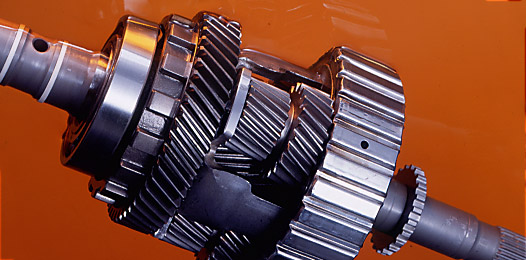
|
|
|
| To advertise your company click here |
Unveiling the hidden beauty of Subaru's mechanical parts
Mechanical Parts |
Center differential gear
"When I entered Subaru in 1982, world's first mass-production of automatic transmission for AWD passenger vehicles was about to start. Since then I have devoted myself to research and development of automatic transmission and center differential." Mr. Kanazawa is a specialist in the area of transmissions and center differentials. However before my interview he warned me of the difficult nature of the topic. "Even engineers studied mechanical engineering at university require more than two days to understand the mechanism of the Subaru's center differential. It becomes even more complicated if we understand Subaru AWD including the relationship of factors such as vehicle control and behavior and suspension settings. I too am still learning." With my lack of fundamental knowledge in mechanical engineering, trying to understand this theory is a daunting prospect. However, rather than the theory, I would like to know what would happen if we didn't have a center differential in a vehicle fitted with AWD. "Without the center differential, an AWD vehicle would probably be fine in slippery conditions, however, in normal, on-road conditions it would be stiff and awkward and would not be fun to drive." Terrific! He is a person who has words a layperson can understand. For people who have driven models of the Leone Station Wagon 1983 or before on rough roads, this "stiff and awkward" handling would be well known. Subaru has sold cars fitted with center differentials since the 1984 Leone. Until then, Subaru's AWD was part-time AWD. When driving on the road, cars used front-wheel drive and, on snow-covered or muddy roads, the cars were switched over to rigid AWD (AWD that doesn't evenly distribute drive power to front and rear wheels). Subaru's center differential has evolved and the 1991 Subaru SVX, with a 3.3-liter, Horizontally-Opposed 6-cylinder engine, was fitted with a variable torque distribution (VTD) center differential. Thus a center differential capable of sports driving had appeared. The exhaustively researched and developed center differential gave birth to a full-time AWD system that is both safe and fun to drive. What is the ideal center differential? "Firstly, it would have to faithfully transmit drive power to all four wheels. Then, it would need to be a simple mechanism that is light, compact and tough. In addition, to provide the most appropriate power to each of the four wheels it must be able to cooperate with the other vehicle control mechanisms." Could you describe this ideal center differential in more detail? "Yes, it is the current Subaru center differential." The Subaru center differential is such compact as unificable with the transmission. When Subaru's center differential was introduced, the engineers from other vehicle manufacturers asked, "Where is the center differential positioned?" This episode remains a source of amusement at Subaru. When I replied that he seemed confident, Mr. Kanazawa responded with a quiet self-assurance. "Subaru pioneered AWD that is fun to drive. It is not that we consider that we have done a tremendous thing or that we have great confidence, however, one thing I can say clearly is that because Subaru is a pioneer we must have thought by ourselves and must have developed things for ourselves. As a result, Subaru's AWD technology will not be surpassed by other manufacturers. Of course, even the center differential, which is but one mechanism that makes up Subaru's AWD, has adopted the ideal form." Subaru's center differential contributes to performance for ideal traction for all four wheels by appropriately distributing the torque. Moreover, a racing driver noted, "Driving a car involves controlling the traction to all four wheels." Subaru's center differential regarded this as important function and actually achieved. The center differential is one of the main factors that enables AWD driving performance, which is responsive and superbly faithful to the driver's will. The VTD of the Subaru Legacy is patented technology called "double-planetary gear type variable torque distribution." This VTD has a mechanism consisting of helical gears-- one front sun gear, one rear sun gear and three planetary gears, and one carrier. I listened to a two-hour explanation with the use of a model about these center differential gears. This explanation was much like an explanation of gears for kindergartener. As a result I think I was able to understand how they work. However, when I look at the movement of the gears of the center differential, the metal gears appear to move freely just like a living thing. In addition, the transfer of drive power to the center differential seems to flow just like liquid. When driving a Subaru AWD vehicle and pushing the car to the limit of tire grip, the rear tires begin to slide very smoothly. Also, during braking, when entering a corner, and accelerating out of a corner, I am surprised at the strong feeling of traction. Now I understand that the secret of smoothness and strong traction I feel when driving a Subaru is due to the center differential. |
Quick Links
Richard Burns
Click here for more information on the 2001 World Rally Champion.
RB320 Features
- £6,000 of extra equipment
- 320PS/450Nm Prodrive tuned
- build limited to 320 units
- finished in Obsidian Black
- bespoke 18" alloy wheels
- unique numbered tax disc holder
- Prodrive tuned suspension system with Bilstein dampers, Eibach springs & rear ARB
- lowered ride height
- polished s/steel mesh front grille
- STI front lip spoiler
- STI quickshift gearchange
- STI side sill plates
- RB branded gear knob
- RB branded car mats
- RB exterior badging